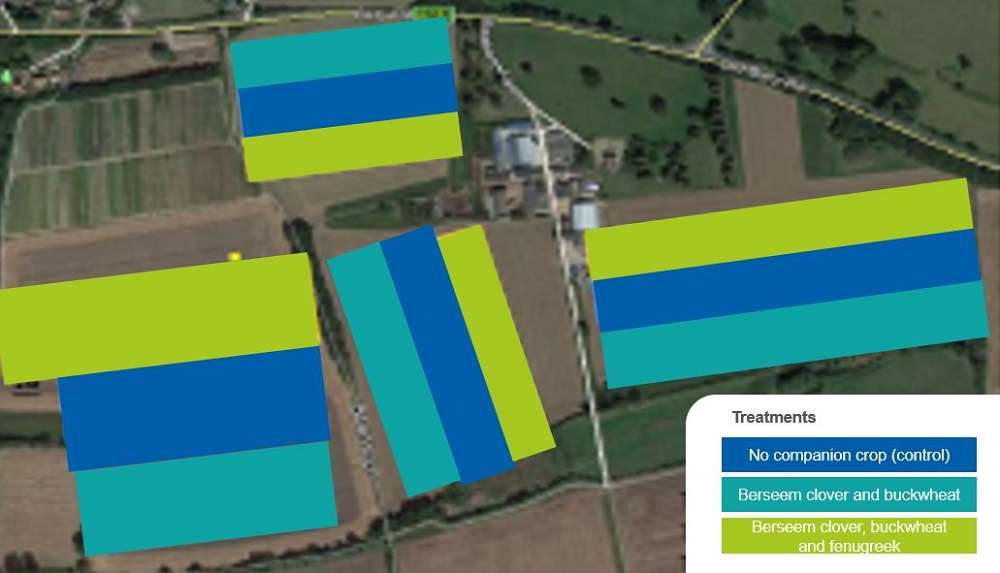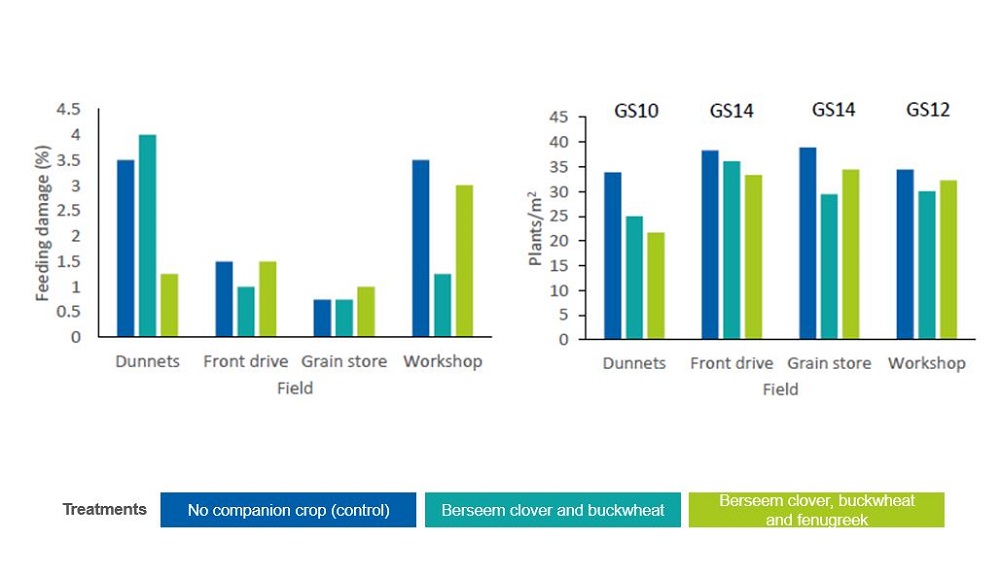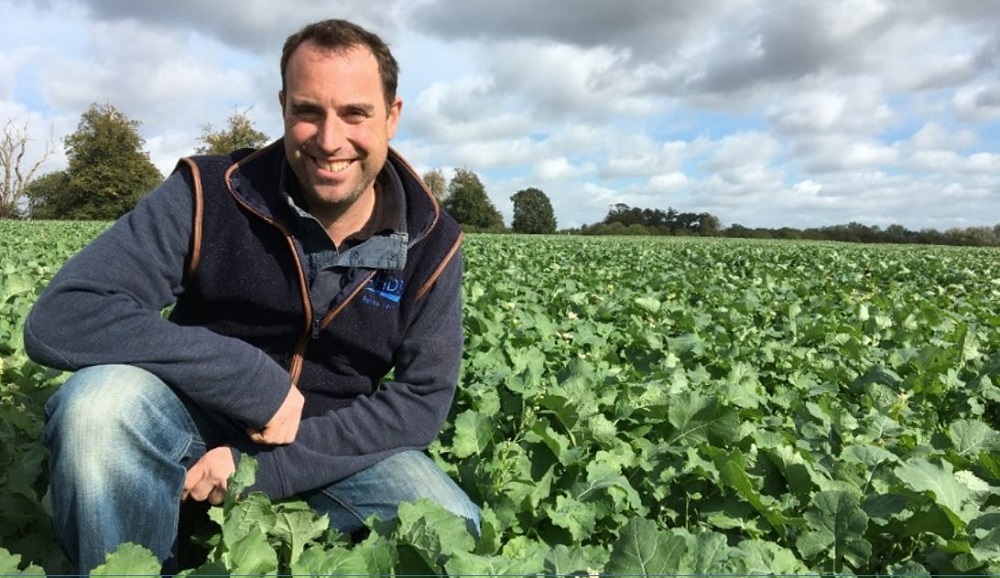Can companion crops give OSR the edge over CSFB?
Monday, 19 July 2021
Recent AHDB research cited companion crops as one of several options for cabbage stem flea beetle (CSFB) management in oilseed rape (OSR). However, with the evidence to support the approach largely anecdotal, Diss Monitor Farmer, Richard Ling, hopes his on-farm trial will help tease out the benefits.
Visit the Diss Monitor Farm home page
CSFB and its management in oilseed rape
How companion cropping works
A potential option for integrated pest management (IPM), companion crops work in one or more ways to suppress beetle activity and/or damage – with the suppression effect influenced by the companion species (and mix) selected. For example, companion crops may help to:
- Attract the pest, diverting it away from OSR
- Mask/hide the crop from CSFB
- Improve the soil, providing stronger conditions for OSR to grow away from damage
- Promote the activity of natural enemies
- Act as a ‘sacrificial’ plant that is eaten by CSFB in preference to OSR
On-farm companion crop trial
Rookery Farm, near Diss in Norfolk, covers 400 ha on varied soil types, from sandy loam to heavy clay loams. Richard values the role OSR plays in the rotation and wants to do what he can to keep growing it.
Earlier, but limited, research detected less damage in crops (two-leaf and five-leaf stage) companion-cropped with either a berseem/clover mix or mustard. With the potential established, Richard started to trial companion crops on his farm in autumn 2019. Last autumn (2020), he took the research to a new level – by replicating three treatments across four fields (see Figure 1):
- Treatment 1: No companion crop – control
- Treatment 2: Two species mix – berseem clover and buckwheat
- Treatment 3: Three species mix – berseem clover, buckwheat and fenugreek
Although other treatments were largely standardised, there were differences in the approach to organic matter across the four fields:
- Field 1 (Dunnets): Cattle farmyard manure
- Field 2 (Front drive): Chicken farmyard manure
- Field 3 (Grain store): Organic liquid material
- Field 4 (Workshop): Cattle farmyard manure
The oilseed rape was drilled on 13 August 2021 with a Vaderstad rapid speed drill into moisture. The companion crop was drilled on the same day (off the back of a low-disturbance subsoiler).

Figure 1. Aerial view of the 2020–21 companion crop trial treatments at the Diss Monitor Farm
Assessing the treatments
The trials are being assessed throughout the season, with assistance from ADAS. The autumn assessments included measurements of feeding damage and plant population counts (Figure 2).
Interestingly, plant populations were highest in the treatment where no companion crop was grown (all fields).
Companion crops can compete with oilseed rape, and care needs to be taken with species selection. An alternative would be to drill the oilseed rape about a week before the companion crop to give it a head start.
The organic amendments had a varying effect on OSR and companion crop establishment, as well as adult CSFB levels in the autumn and larvae levels in the winter.

Figure 2. CSFB feeding damage and plant population counts at the Diss Monitor Farm
Plant size, across all fields, is highly variable – making it hard to detect clear differences. However, there were some encouraging early signs.
Richard said: “There were definitely some benefits from the companion crops. They did appear to hide the oilseed rape from cabbage stem flea beetle attack. However, the jury is out until harvest as to the final effect.”
Companion crop questions
As with many on-farm trials (and traditional research trials), more questions are thrown up than answers. The current list of questions includes:
- Are we using the right companion crops?
- Are the companion crops delivering other benefits – such as weed suppression and nutrition?
- On nutrition, will the clover make N available and will the buckwheat release P to help boost early growth?
- Would assessments of biomass provide a better indication of crop damage, compared to larval and plant population assessments?
Further information
To get involved in the debate and for the latest results, make sure you follow the activity of the Diss Monitor Farm: ahdb.org.uk/farm-excellence/diss
You can also join the conversation on Twitter. Please include @TheRookeryFarm and @AHDB_Cereals in any tweet.
For more information about CSFB, visit ahdb.org.uk/csfb.
Sites required for CSFB research
Our latest CSFB research project – ‘Reducing the impact of cabbage stem flea beetle (CSFB) on oilseed rape in the UK’ (2020–23) – needs you! The ADAS-led project aims to improve understanding of the pest’s biology and investigate management options.
As part of the work, they need commercial OSR field sites to host 2021–22 season trials on:
- Companion crops (crop sown between mid-August and early September)
- Stubble lengths (crop sown between mid-August and early September)
- Organic amendments (crop sown between mid-August and early September)*
- Seed rates (crop sown in early August or July)*
Find out more (including how to get involved in the trials)
*To date, more interest has been expressed in the companion crop and stubble length trials. ADAS is particularly keen to hear from growers interested in participating in the organic amendment and seed-rate trials.
Finally, is your oilseed rape 'beautiful'?
Do you think your OSR crop could win a beauty contest? The establishment beauty contest is returning for a second season. The AHDB-funded initiative, which is part of the Oilseed Yield Enhancement Network (YEN), has three entries available (based on drilling date). In addition to getting involved in some competitive fun, the data collected will help narrow down the factors associated with establishment success, failure and everything in between.

Topics:
Sectors:
Tags:

